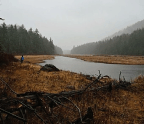
On August 12, just days after floods washed aways roads, bridges, and dams in the central Adirondacks, Ontario writer Jamieson Findlay poured over a map spread out on a picnic table at a state campground in Newcomb. Bill Brown, a retired scientist, gave navigation advice, while Bill Barkley, Findlay’s childhood friend and hiking partner, listened intently nearby.
Findlay would make a month-long trek from the Adirondack Park to Algonquin Park following the Pilgrimage for Nature Trail, which had been created to bring awareness of the wildlife corridor between the two parks.
“It's going to rejuvenate me and recharge my batteries,” Findlay, 64, said after setting out on the journey.
The nonprofit Algonquin to Adirondacks Collaborative (A2A) touts the area as “one of the last large-scale, intact forest and wetland linkages left in Eastern North America.”
Advocates say safe wildlife corridors are




